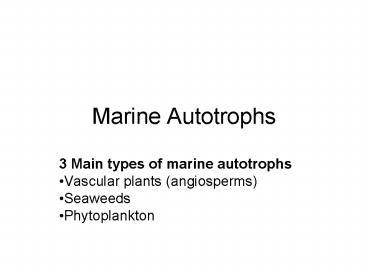Marine Autotrophs - PowerPoint PPT Presentation
1 / 22
Title:
Marine Autotrophs
Description:
Mangroves can tolerate really tough conditions, including salt water, but they ... The multicellular algae (aka seaweeds) are divided into 3 ... Sea lettuce ... – PowerPoint PPT presentation
Number of Views:178
Avg rating:3.0/5.0
Title: Marine Autotrophs
1
Marine Autotrophs
- 3 Main types of marine autotrophs
- Vascular plants (angiosperms)
- Seaweeds
- Phytoplankton
2
There are only a few species of marine
angiosperms (flowering plants)
Mangroves
Sea grass
3
Mangroves can tolerate really tough conditions,
including salt water, but they cant tolerate
frost
equator
They are always found within 20 30 degrees of
the equator
4
The multicellular algae (aka seaweeds) are
divided into 3 main groups
- Chlorophytes Green algae
- Phaeophytes Brown algae
- Rhodophytes Red algae
Seaweeds are not considered plants per se.
Instead they belong to the Protist kingdom, along
with protozoa and single celled algae Seaweeds
are photosynthetic autotrophs, and contribute
about 3 of the oceans primary productivity
5
Phylum Chlorophyta
Sea lettuce
Chlorophytes, or green algae, are the seaweeds
found closest to the oceans surface, where the
sunlight is the strongest
Spongeweed, or Dead Mans Fingers
6
Phylum Phaeophyta brown algae
Giant kelp Macrocystis pyrifera
7
Phylum phaeophyta brown algae
Bull kelp Pelagophycus porra
Feather boa kelp Egregia menziesii
8
Kelp can tolerate really tough conditions but
they cant tolerate warm water
equator
They are normally found in temperate to polar seas
9
Phylum Rhodophyta red algae
Coralline red algae Corallina vancouveriensis
10
Phytoplankton single celled algae
The main groups are
- Phylum Chrysophyta golden algae
- Diatoms
- Coccolithophores
- Phylum Pyrrophyta dinoflagellates
- Picoplankton
- About 95 of all ocean primary productivity is
due to phytoplankton
11
Diatoms
- The test (shell) is made of silica
- - Pores in the test let water, CO2, and nutrients
in, oxygen and waste products out - These autotrophs are very efficient at
photosynthesis
50 mm
Diatoms divide asexually
12
Many diatoms are social, forming chains and
other structures
The spines are both for defense and to reduce
sinking
13
Coccolithophores
Are tiny compared to diatoms (about the size of
bacteria)
But can produce huge blooms like this one in 2000
in the Bering Sea
14
Dinoflagellates
Characterized by flagella (little tails that
propels them (like sperm cells)
15
Dinoflagellates
Are not your usual plants
Sometimes the population explodes, forming a red
tide
They can be heterotrophic, like this Noctilucca
eating a diatom chain
16
Many dinoflagellates bioluminesce when stimulated
by water motion. Why?
17
Picoplankton are smaller even than
coccolithophores
18
Quantitative Biological Oceanography
Distribution of Marine Autotrophs
Recall McGehees 6 questions of Biological
Oceanography
- What species of organisms are found in the ocean?
- How do these organisms make a living?
- How are they distributed in the ocean, both
vertically and horizontally - What factors govern the patterns of distribution?
- What are the communities of organisms?
- What factors govern community structure?
19
Simplest measure of distribution Presence vs.
absence
equator
This maps shows where kelp and mangroves are
present, and where they are absent. It invites
interpretation, doesnt it?
20
Estimating Phytoplankton Biomass using
fluorescenceExample from the Ligurian Sea
between France, Italy, and CorsicaThe peak in
vertical distribution of chlorophyll is shallower
in the center of the basin than at the edges
21
Isopycnals (lines of constant density) show an
upwelling in the center of the Ligurian Basin
22
The chlorophyll maximum is associated with a
particular density of water
Can you offer an explanation for this?































